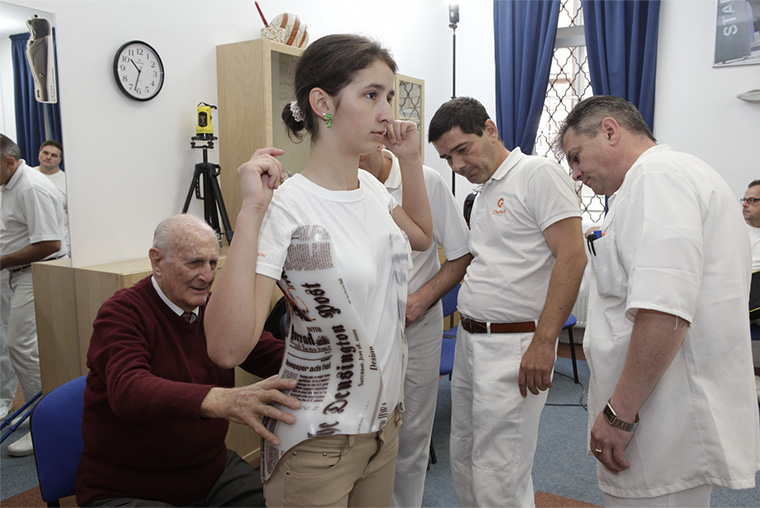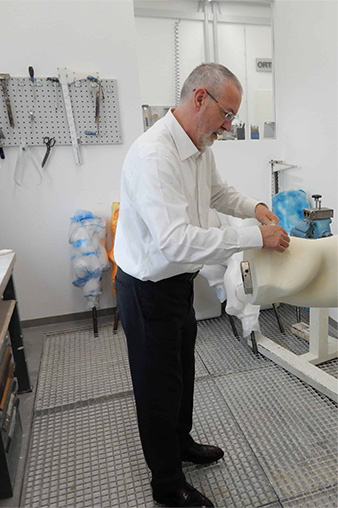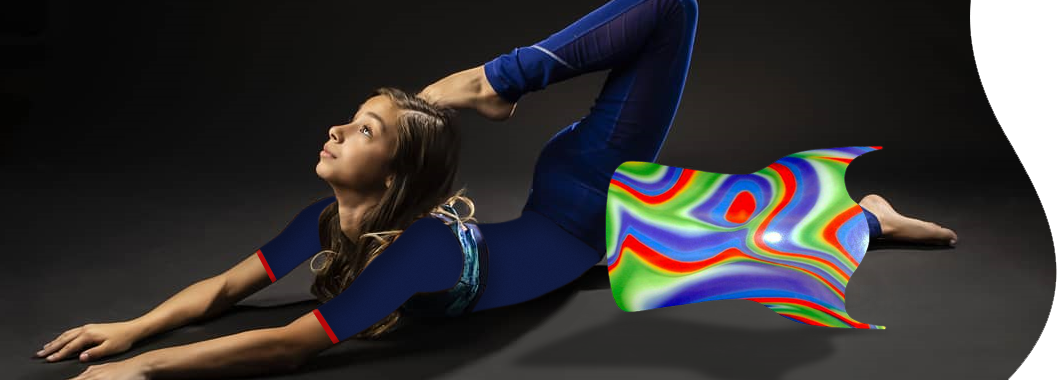Based on the breakthrough work of Dr. Chêneau and Dr. Rigo, today’s WCR (Wood-Chêneau Rigo) brace represents the most advanced therapeutic orthotic equipment for the effective restoration of normal posture. It is widely recognized as the gold standard in scoliosis treatment and has seen remarkable success among its users. Read on for more information about scoliosis and how this innovative form of therapy is helping people to reclaim their lives.
Understanding Scoliosis
Scoliosis is a condition that affects the spine, causing it to curve. This condition is most commonly seen in teenagers but can occur at any age. It affects 2-3% of the population worldwide and can range from mild to severe. The exact cause of scoliosis is still unknown but may be due to a combination of genetic and environmental factors.
In mild cases of scoliosis, the spine may look normal when standing but will curve to one side when bent forward. In more severe cases, the spine can curve to the side in a C or S shape. Rib cage, shoulder blade, and hip heights may also be uneven.
The primary treatment for scoliosis is bracing. Braces help to keep the spine straight while it grows. Surgery is also an option, although it’s generally for more severe cases.
Scoliosis Classification
Scoliosis is classified by etiology, meaning the cause or origin of the condition. Its three major categories are idiopathic, congenital, and neuromuscular.
Idiopathic Scoliosis
Idiopathic scoliosis is the most common type of scoliosis and is typically seen in teenagers. It occurs when there is no known cause for the condition. Treatment for idiopathic scoliosis includes bracing and physical therapy, as well as monitoring the progression of scoliosis during growth spurts.
Congenital Scoliosis
Congenital scoliosis is caused by a bone deformity present at birth and can range from mild to severe. The deformity can occur on one side of the spine or both. Treatment for congenital scoliosis is typically surgery.
Neuromuscular Scoliosis
Neuromuscular scoliosis is caused by an underlying medical condition such as cerebral palsy or muscular dystrophy. It’s characterized by uneven muscle tone on one side of the body, which can cause the spine to curve in that direction. Treatment for neuromuscular scoliosis typically includes bracing, physical therapy, and possibly surgery.
Rigo-Chêneau Brace Therapy
Rigo-Chêneau brace therapy, also known as WCR brace therapy, is a non-invasive treatment for mild to moderate scoliosis. It involves the use of a custom-made brace that is designed to fit snugly and comfortably around the torso, allowing for normal movement while helping to keep the spine straight.
How WCR Brace Therapy for Scoliosis Set a New Standard for Treatment
Scoliosis wasn’t always treated with Rigo-Chêneau brace therapy. Traditionally, orthotic devices such as the Boston Brace helped to correct scoliosis. However, these types of braces are bulky and uncomfortable, often hindering the wearer’s ability to move freely. They’re also two-dimensional, meaning they can’t correct the complex three-dimensional deformity of scoliosis.
From a superficial perspective, the spine of a scoliosis patient appears as a C or an S shape. However, an internal view reveals a much more complex confluence of factors. The vertebrae in the spine rotate as they form a curve; spaces between the vertebrae may become compressed in some areas and stretched in others. Due to these irregularities, corrective measures for scoliosis require a 3-D approach to address the curve from all angles.
Dr. Jaques Chêneau was the first to recognize the limitation of two-dimensional braces and developed a brace that attempted to treat all aspects of scoliosis in 1978. This new and improved brace was designed to correct the lateral (side-to-side) deviation and rotation, as well as the sagittal (front-to-back) curve of the spine.
Chêneau’s design was further refined by Dr. Emanuel Rigo of Barcelona using biomechanical principles. This made for a comfortable brace that still effectively treats mild to moderate scoliosis. Researchers in the United States also had a hand in developing the Rigo-Chêneau brace therapy, making it the most popular scoliosis brace in use today.
 Dr. Jacques Cheneau
Dr. Jacques Cheneau Dr. Emanuel Rigo
Dr. Emanuel Rigo The Rigo-Chêneau brace is custom designed for each patient, considering pressure points and breathing points. It is lightweight, comfortable, and allows for normal movement while providing structure and support to the spine. Countless studies prove Rigo-Chêneau brace therapy’s effectiveness in reducing scoliosis curvature and recommend it as an alternative to surgery in mild to moderate cases of the condition.
What Rigo-Chêneau Brace Therapy Can Correct
Rigo-Chêneau brace therapy is designed to address deformities of the transversal plane, which is the plane that runs from side to side across the body. It’s this type of deformity that causes scoliosis curves and rotations in the spine. The brace helps to correct alignment by providing a corrective force that halts the progression of any existing deformities and prevents new ones from forming.
The Rigo-Chêneau brace system also addresses deformities in the three-dimensional plane, which encompasses the vertical, forward-bending, and lateral curves of the spine. This type of corrective force is incredibly effective for conditions such as Kyphosis (humpback) and Lordosis (swayback).
Benefits of WCR Brace Therapy for Scoliosis
Rigo-Chêneau brace therapy is a safe and effective treatment option for mild to moderate scoliosis. It offers a number of advantages over traditional braces, including:
Comfort and Mobility
The lightweight and breathable materials of the Rigo-Chêneau brace make it much more comfortable to wear than traditional braces. It also allows for normal movement and flexibility, allowing the patient to remain as active as possible while receiving treatment. Patients may also experience improved posture, which can contribute to reduced pain and improved mobility.
Reduced Treatment Cost
Due to its non-invasive nature, Rigo-Chêneau brace therapy costs significantly less than surgery. A brace is created and fitted to the patient’s exact measurements and then adjusted over time. This eliminates the need for frequent visits to the doctor or hospital, which keeps costs down as well.
Improved Treatment Outcomes
Numerous studies have shown that Rigo-Chêneau brace therapy is highly effective to treat scoliosis. In many cases, this non-invasive intervention can halt the progression of the condition and reduce the curve in the spine, thus avoiding any need for surgery. It can even help prevent the development of new curves and deformities.
Non-Invasive Treatment Option
Unlike surgery, Rigo-Chêneau brace therapy does not require a lengthy hospital stay or long recovery period. The treatment is conducted in an outpatient setting and the patient can return home with minimal disruption to their daily life. It’s also a much safer option, as it avoids the risks associated with surgical procedures.
Improved Quality of Care
Rigo-Chêneau brace therapy allows for a much more individualized approach to scoliosis treatment, with each patient receiving a brace customized to their exact measurements. This individualized approach increases the comfort and efficacy of the treatment. It also allows practitioners to follow the progress of their patients more closely, with corrective adjustments being made as needed.
How Does the WCR Bracing Method Work?
Rigo-Chêneau brace therapy for scoliosis works by applying a three-dimensional corrective force to the spine, effectively counteracting the curvature. The forces applied by the brace are adjusted for each patient depending on their individual needs and the severity of their condition.
Measurement and Fitting
Before a patient can be fitted for the Rigo-Chêneau brace, they must first have their scoliosis measured by a doctor. This process involves taking X-rays and other imaging tests to determine the exact location, size, and degree of curvature in the spine.
Once the measurements are taken, a software program is used to design and fabricate an individualized brace for each patient. The brace is then adjusted and fitted to provide the best possible support while still allowing for normal movement.
Material and Comfort
The WCR brace is made of a lightweight thermoplastic material called polypropylene. It’s designed to be virtually unnoticeable underneath the patient’s clothing and is usually quite comfortable after a few days of wear. While some patients may experience discomfort initially, it generally goes away within a week.
The Rigo-Chêneau brace is also adjustable, allowing for incremental changes in positioning as the treatment progresses. This ensures that the patient can get the maximum benefit from the device and that their spine is kept in proper alignment throughout the entire process.
Wear Time
Rigo-Chêneau brace therapy is typically recommended for 18-23 hours per day, depending on the individual patient’s needs. It can be worn while doing everyday activities such as walking, playing sports, and even swimming. However, it’s important to remember that the brace must be worn consistently in order for treatment to be successful.
Rigo-Chêneau Brace Therapy: A Conservative and Effective Treatment for Idiopathic Scoliosis
Rigo-Chêneau brace therapy is a safe, non-invasive treatment option for those with mild or moderate idiopathic scoliosis. It is effective in reducing the curvature of the spine, as well as improving posture and alignment.
The therapy has been refined countless times over the years, more recently by Grant Wood, who specializes in the conservative treatment of scoliosis. His approach combines the Rigo-Chêneau brace and the Schroth method of physical therapy, offering patients a comprehensive and effective solution to their condition. Mónica Villagrasa has also made significant improvements to the Rigo-Chêneau brace, creating a thermoplastic version that is more comfortable and durable than ever before.
With the help of both Wood and Villagrasa, the Rigo-Chêneau brace is now considered one of the most reliable treatments for idiopathic scoliosis. It’s an affordable and conservative option for those looking to reduce the curvature of their spine without surgery.
Today’s WCR devices are light-years ahead of the cumbersome cage-like braces of yesteryear. They are made of lightweight materials that provide maximum comfort and correction while remaining virtually unnoticeable underneath clothing. With the help of a trained practitioner, the Rigo-Chêneau brace can be a game-changer in treating scoliosis.
Schedule a consultation with a doctor today to find out if the Rigo-Chêneau brace is right for you!


